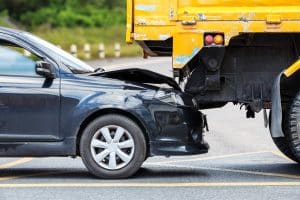The Dangers of Truck Underride Accidents
 North Dakota is home to a lot of commercial trucks, especially because of our thriving mining, quarry, and oil/gas extraction industries. With all of these construction, semi, and tanker trucks on the highways, accidents are bound to occur, and, occupants of passenger vehicles almost always take the brunt of the damage in these accidents due to their vehicle’s smaller size and weight.
North Dakota is home to a lot of commercial trucks, especially because of our thriving mining, quarry, and oil/gas extraction industries. With all of these construction, semi, and tanker trucks on the highways, accidents are bound to occur, and, occupants of passenger vehicles almost always take the brunt of the damage in these accidents due to their vehicle’s smaller size and weight.
One of the most severe and dangerous types of truck accidents is called an underride accident. The safety advocacy site Stop Underrides describes them:
Truck underride is what frequently happens when a passenger vehicle collides with a large truck. The passenger vehicle goes under the truck and the crashworthy safety features of the car are not able to work. Or, to put it another way, the truck enters the passenger occupant space of the smaller vehicle — too often resulting in horrific death and debilitating injuries.
There are two main types of these devastating underride accidents; side and rear. A side underride accident happens when a car slides or is pushed under the side of a truck during a collision. A rear underride accident occurs when a car slides or is pushed under the rear of the truck.
Side and rear guards are meant to prevent these types of accidents from happening. NBC News reports calls for truck guards began after the tragic death of actress Jayne Mansfield over 50 years ago, when a car in which she was a passenger slid under the back of an 18-wheeler. However, it took all the way until 1998 for the National Highway Traffic Safety Administration (NHTSA) to mandate rear guards on tractor trailers. Currently, side guards are recommended, but not required.
Why do underride crashes happen?
Underride crashes, just like many motor vehicle accidents, can happen for any number of reasons. According to truck underride collision analyst John Glennon, the following factors often come into play:
- Low vision situations, like nighttime or low sun angles. Motorists may not see a truck crossing an intersection, backing up, braking, or attempting another type of maneuver, and crash into it.
- Lack of color contrast and reflectors on the truck. With improperly placed or too few lights and reflectors on a trailer, nighttime drivers may not recognize it as a danger in time to stop safely.
- Slow-moving trucks. When trucks are moving too slowly for traffic conditions, motorists may not recognize this change in speed and be unable to stop in time to prevent an accident.
- Inoperative, dim, or dirty taillights. If a semi-truck makes a sudden stop and the vehicle behind cannot see the brake lights, it runs the risk of a rear underride accident.
One thing that can help? Underride guards. David Harkey, who directs the University of North Carolina Highway Safety Research Center, said at a 2016 underride roundtable, “When people talk about Vision Zero, often what comes to mind is the potential for self-driving vehicles to eliminate crashes entirely. While technology holds a lot of promise, it’s going to take a long time to get there. There are things we can do now to save lives, and side underride guards are a perfect example.”
Can underride crashes be prevented?
Safety advocates and experts have worked to pass legislation mandating both rear and side underride guards for several years, including several attempts to pass the Stop Underrides Act in Congress. These efforts, up until recently, were stymied in part by trucking companies, who do not believe enough studies and research have been done on the effectiveness of sideguards as compared to the overall cost.
However, the Biden Administration’s Infrastructure Law, passed in late 2021, includes provisions to improve truck underride guards. The Insurance Institute for Highway Safety (IIHS), which provided some of the research on which the law is based, reports some of the changes:
Another longstanding IIHS-HLDI priority included in the legislation is improvements to truck underride guards. The bill calls for an updated rear underride standard that would incorporate at least two of the three requirements for the IIHS TOUGHGUARD award: Guards would have to prevent underride by a passenger vehicle traveling 35 mph when it strikes the rear of a trailer in the center or with a 50 percent overlap. It also calls for regulators to consider requiring the most challenging part of the IIHS evaluation, the 30 percent overlap crash.
Further, the legislation also requires the Department of Transportation to research the feasibility of side underride guards and, if warranted, develop regulations and standards.
What kinds of injuries do underride crashes cause?
Because a vehicle’s passenger compartment can slide underneath a truck in an underride collision, injuries from these accidents can be devastating and catastrophic, with victims sustaining:
| · Traumatic brain injuries
· Internal injuries · Organ damage |
· Broken and fractured bones |
In addition to physical trauma from underride accidents, victims often experience mental trauma, as these types of collisions tend to be violent and frightening. Even after the accident, you still have to worry about medical bills, lost wages and, depending on the severity of your injuries, adjusting to a new way of life. Our injury attorneys understand how overwhelming these issues can be for you and your family, and you do not have to go through it alone.
The Minot truck accident attorneys at Larson Law Firm, P.C. understand the catastrophic nature of rear and side underride crashes and collisions. We know that you and your family need help now, and we can help you file a legal claim as soon as possible against all negligent parties. For experienced and knowledgeable guidance, call 701-484-HURT or complete our contact form to schedule a consultation. We maintain offices in Minot, Fargo, and Bismarck.

Mark Larson is a Certified Civil Trial Specialist and Certified Civil Pre-Trial Specialist focusing on personal injury, car accidents, wrongful death, and oil field claims. Since 1979, Larson Law Firm has served the injured throughout North Dakota. Read more about Mark V. Larson.
